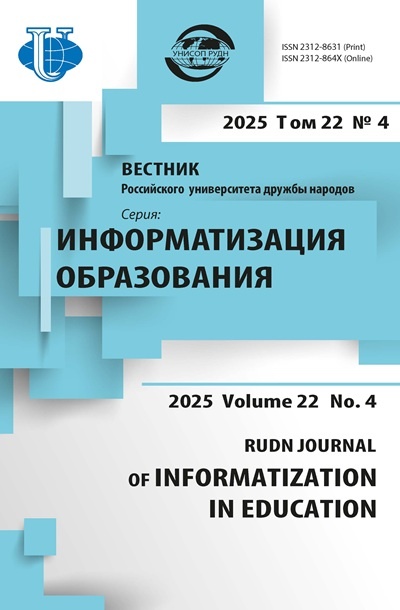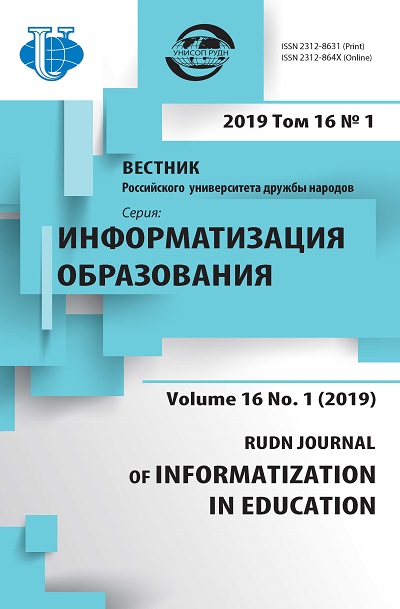Criteria and levels of formation of the logical competence to design mobile computer applications
- Authors: Nurbekova Z.K.1, Aimicheva G.I.1
-
Affiliations:
- L.N. Gumilyov Eurasian National University
- Issue: Vol 16, No 1 (2019)
- Pages: 81-88
- Section: COMPUTER SCIENCE TEACHING
- URL: https://journals.rudn.ru/informatization-education/article/view/20845
- DOI: https://doi.org/10.22363/2312-8631-2019-16-1-81-88
- ID: 20845
Cite item
Full Text
Abstract
Problem and goal. The article deals with the problem of formation of logical competence in the design of mobile applications for future teachers of informatics. From the position of the competence approach in the structure of logical competence in the design of mobile applications are allocated motivational, cognitive, activity, communicative, reflexive components. Special attention is paid to the criteria and levels of formation of logical competence of future teachers of informatics in the design of mobile applications. Methodology. To diagnose the degree of formation of logical competence in the design of mobile applications are three levels: reproductive, productive and creative. Results. Five criteria aimed at determining the degree of understanding and application of the logical-algebraic apparatus in the development of mobile applications, generating new knowledge based on the experience and the possibility of applying the experience in the professional field are formulated. The article provides an example of determining the degree of formation of logical competence for the design of mobile applications. Conclusion. Reproductive and productive levels demonstrate the ability of students to design mobile applications based on a ready-made template or instructions. Creative level is the highest level of formation of logical competence of the student, indicating the ability to create mobile applications at a professional level on the basis of experience.
Full Text
Постановка проблемы. Уровень развития национальной экономики напрямую зависит от уровня образованности человеческих ресурсов. Молодежь, воспитанная на таких вечных ценностях, как профессионализм, нравственность и интеллект, является настоящей опорой для своей страны [6]. Одной из слагаемых профессиональной компетентности учителя информатики является умение разрабатывать программное обеспечение в соответствии с требованиями технического задания, нормами и стандартами. Востребованным в мире направлением является разработка мобильных приложений, которая включает такие этапы, как анализ и формализация задачи, проектирование, кодирование, тестирование прототипа, корректировка и публикация готовой версии приложения [3; 5; 9]. Методы исследования. Для правильной разработки мобильного приложения в условиях ограниченности ресурсов мобильных устройств необходимым является владение логико-алгебраическим аппаратом: выделение уровней и элементов абстракции, декомпозиция состояний приложения, описание бизнес-логики и иерархии классов, доказуемость правильности выбора алгоритма, оптимизация программного кода, управление памятью [3; 6; 9]. Раскрытие содержания логикоалгебраического аппарата в условиях разработки мобильных приложений способствует развитию логической компетенции по проектированию мобильных приложений. Ее формирование предполагает обучение студентов - будущих учителей - проектированию мобильных приложений путем углубления знаний, раскрытия содержательной части этапов проектирования через логико-алгебраический аппарат, необходимый для дальнейшего применения в профессиональной деятельности [1; 2; 4; 8; 11]. При формировании логической компетенции важным является вопрос определения критериев и диагностики уровней сформированности логической компетенции. С этой целью в структуре логической компетенции по проектированию мобильных приложений выделены мотивационная, когнитивная, деятельностная, коммуникативная, рефлексивная компоненты [10]. Кроме того, определены основные требования к знаниям, умениям, навыкам студентов и опыту их применения в ходе проектирования мобильных приложений [3; 11; 12; 14]. Перечислим их: · анализ требований и формализация задачи; · доказательство выбора шаблона проектирования; · декомпозиция модели мобильного приложения с определением возможных состояний и переходов между ними; · определение оптимального способа организации и доступа к данным; · определение структуры классов мобильного приложения; · доказательство завершенности алгоритма и его эффективности; · доказательство многократного использования кода; · тестирование, отладка и оптимизация приложения. Выделим три уровня сформированности логической компетенции по проектированию мобильных приложений: репродуктивный, продуктивный и творческий, и критерии, которые необходимы для диагностирования эффективности формирования логической компетенции по проектированию мобильных приложений [2] (см. таблицу). Определение уровня сформированности перечисленных выше компонентов логической компетенции по проектированию мобильных приложений будет осуществляться через анкетирование, тестирование, оценку разработанных студентами приложений. Результаты и обсуждение. Рассмотрим диагностирование уровня сформированности (L1-L3) логической компетенции студентов при практической разработке мобильных приложений. В качестве примера проанализируем проект мобильного приложения «Погода». Данное приложение может быть выполнено студентами в нескольких вариантах. Компоненты Критерии Уровни сформированности компетенции Репродуктивный (L1) Продуктивный (L2) Творческий (L3) Мотивационный Понимание значимости логикоалгебраических методов при проектировании мобильного приложения и в профессиональной деятельности (K1) Студенты понимают смысл логико-алгебраических методов на этапах проектирования мобильных приложений, но не заинтересованы в их использовании для разработки эффективного мобильного приложения Студенты проявляют заинтересованность к возможностям применения логико-алгебраических методов при проектировании мобильных приложений, уверены в способности применять их при решении аналогичных задач Повышенный профессиональный интерес к проектированию мобильных приложений с применением логикоалгебраического аппарата. Готовность к самообразованию с целью получения дополнительных знаний и их применения в профессиональной сфере Когнитивный Использование логико-алгебраического аппарата при формировании функциональных и структурных элементов мобильного приложения (K2) Студенты владеют необходимыми знаниями логико-алгебраического аппарата для разработки простых мобильных приложений и выполняют небольшие проекты с пошаговой инструкцией Студенты владеют необходимыми знаниями логико-алгебраического аппарата и могут применять их для самостоятельной разработки типовых проектов Студенты успешно справляются с разработкой сложных проектов, применяя логико-алгебраический аппарат для доказательства алгоритмов и способов организации данных. Способны к трансформации знаний применительно к другим условиям Деятельностный Обоснованный выбор технологии программирования, алгоритмов и способов доступа к данным и описания бизнес-логики мобильного приложения (K3) Неаргументированный выбор технологии программирования. При организации способов доступа к данным не учитывается ограниченность ресурсов. Профессионально неосознанная деятельность на репродуктивном уровне Для аргументации действий требуется консультация преподавателя. Алгоритм разработки мобильного приложения исполняется последовательно и логически обоснованно Профессиональный подход к разработке мобильного приложения на высоком уровне. Проявляется творческий подход к решению задач и использованию в профессиональной сфере Коммуникативный Реализация коммуникации на аппаратном и межличностном уровнях (K4) Разработанный диалоговый интерфейс между пользователем приложения и мобильным приложением реализован стандартным решением. Межличностное общение не затрагивает сферу профессиональных интересов Интерфейс диалогов располагает к себе пользователя, частично заменяя живое общение с человеком. В общении между одногруппниками наблюдаются дискуссии на профессиональные темы Наблюдается слаженная работа в команде и общение между студентами и с преподавателем на профессиональном языке. Доказательство выбранных решений выполняется на профессиональном уровне Рефлексивный Самореализация в профессиональной сфере (K5) Студенты оценивают собственную деятельность, но не стремятся к ее улучшению и профессиональному росту Студенты анализируют собственные проекты, понимают и исправляют свои ошибки, но не могут сделать выводы об эффективности и пригодности опыта логико-алгебраических знаний в будущей профессиональной сфере Студенты осознают уровень владения и возможности применения логикоалгебраических методов в профессиональной сфере. Проводят анализ и оценку собственной деятельности на высоком уровне Вариант A. Простое однооконное мобильное приложение информативного характера, сообщающее краткую информацию о погоде на текущую дату в заданном городе. Данные о погоде загружаются из интернета в формате Json. Студент умеет посылать запрос к серверу и обрабатывать его результат, извлекая нужные ему данные для отображения в окне мобильного приложения. Отсутствует возможность выбора города, подробная информация о погоде и прогноз на ближайшие дни (рис. 1). Такое мобильное приложение соответствует уровню L1 логической компетенции по проектированию мобильных приложений. Рис. 1. Однооконное мобильное приложение, соответствующее уровню L1 логической компетенции по проектированию мобильных приложений Вариант Б. Мобильное приложение «Погода» содержит расширенный функционал, отображающий информацию о погоде в выбранном из списка городе. Причем список городов задан статическим табличным списком. Данные о погоде выбранного города загружаются из интернета в формате Json. Студенты демонстрируют умение создавать динамический запрос к серверу, организовывать необходимую иерархию классов, многопоточность в приложении. Переходы между состояниями логически продуманы (рис. 2). Если данный проект выполнялся группой студентов, это характеризует умение декомпозировать задачу на более мелкие, распределять обязанности и согласованно работать в группе. Отсутствует детальная информация о погоде, возможность просмотра погоды в любом городе, прогноз погоды на ближайшие дни, не используется система позиционирования. Такое мобильное приложение свидетельствует о сформированности логической компетенции на уровне L2. Вариант В. Полнофункциональное мобильное приложение «Погода» с возможностью просмотра полной информации о погоде (осадки, влажность, атмосферное давление, характер погоды, направление и скорость ветра) любого города, выбранного пользователем из динамического списка городов, получаемых с сервера. По желанию пользователя в окне мобильного приложения или в окне браузера, отрываемого с разрешения пользователя, может отображаться дополнительный прогноз на несколько дней вперед. Кроме того, приложение может автоматически определять текущее местонахождение пользователя через систему позиционирования мобильного устройства (рис. 3). Такое приложение характеризуется четкой логикой структурных и функциональных элементов, причинноследственными связями, коротким временем отклика, организацией удаленного хранения данных и выполнением запросов на стороне сервера. Такой вариант мобильного приложения свидетельствует о логической компетенции уровня L3. Рис. 2. Мобильное приложение с расширенным функционалом, соответствующее уровню L2 логической компетенции по проектированию мобильных приложений Рис. 3. Полнофункциональное мобильное приложение, соответствующее уровню L3 логической компетенции по проектированию мобильных приложений Заключение. Для определения критериев и уровней сформированности логической компетенции по проектированию мобильных приложений выделены пять обобщенных критериев, которые направлены на определение степени понимания и применения логико-алгебраического аппарата при разработке мобильных приложений, генерирования новых знаний на основе полученного опыта и возможности применения полученного опыта в профессиональной сфере. Данные критерии и уровни могут быть использованы для диагностики уровня сформированности логической компетенции по проектированию мобильных приложений у студентов специальности «Информатика», а также учителями информатики в качестве средства диагностики уровня сформированности логической компетенции обучаемых. Данное исследование служит основой для дальнейшей разработки модели формирования логической компетенции по проектированию мобильных приложений с целью построения эффективной методической системы обучения студентов специальности «Информатика» проектированию мобильных приложений.
About the authors
Zhanat Kunapianovna Nurbekova
L.N. Gumilyov Eurasian National University
Author for correspondence.
Email: zhanat_n@mail.ru
doctor of pedagogical sciences, full professor, dean of the faculty of information technologies
2 Satpayev St., Astana, 010008, Republic of KazakhstanGaukhar Islyamovna Aimicheva
L.N. Gumilyov Eurasian National University
Email: aimicheva@mail.ru
PhD student of the computer science department
2 Satpayev St., Astana, 010008, Republic of KazakhstanReferences
- Grigoriev S.G., Grinshkun V.V., Remorenko I.M. “Umnaya auditoriya”: ot integracii tekhnologij k integracii principov [“Smart audience”: from the integration of technologies to integrate the principles of]. Informatika i obrazovanie [Informatics and education]. 2013. No. 10. Pp. 3—8.
- Grinshkun V.V., Remorenko I.M. Frontiry “Moskovskoj ehlektronnoj shkoly” [Frontiers of “Moscow electronic school”]. Informatika i obrazovanie [Informatics and education]. 2017. No. 7. Pp. 3—8.
- Dejkstra Eh. Disciplina programmirovaniya [Discipline of programming]. M.: Mir, 1978. 275 p.
- Mirzoev M.S. Teoretiko-metodicheskie osnovaniya formirovaniya matematicheskoj kul’tury uchitelya informatiki [Theoretical and methodical bases of formation of mathematical culture of the teacher of informatics]: monografiya. M.: Prometej, 2015. 306 p.
- Molly M., Kim T., David M. Swift 3: razrabotka prilozhenij v srede Xcode dlya iPhone i iPad s ispol’zovaniem iOS SDK [Swift 3: develop applications in Xcode environment for iPhone and iPad using iOS SDK]. M.: Williams, 2017. 898 p.
- Nahavandipur V. Razrabotka prilozhenij dlya iPhone, iPAD i iPOD [Application development for iPhone, iPAD and iPOD]. SPb.: Piter, 2013. 861 p.
- Nurbekova Zh.K. Teoretiko-metodologicheskie osnovy obucheniya programmirovaniyu [Theoretical and methodological foundations of teaching programming]: monografiya. Pavlodar: PGU im. S. Torajgyrova, 2004. 225 p.
- Pupyshev V.V., Kupchinaus S.Yu. O konstruktivno-logicheskoj kompetentnosti v programmirovanii [On structurally-logical competence in programming]. Sovremennye informacionnye tekhnologii v obrazovanii i nauchnyh issledovaniyah [Modern information technologies in education and scientific research]. 2013. Pp. 149—153.
- Hat’ko E.E. Issledovanie i razrabotka metoda, modelej i algoritmov testirovaniya prilozhenij dlya mobil’nyh ustrojstv [Research and development of method, models and algorithms for testing applications for mobile devices]: dis.. kand. tekhn. nauk. M., 2013. 169 p.
- Hutorskoj A.V. Kompetencii v obrazovanii: opyt proektirovaniya [In education: experience in designing]. M.: INEHK, 2007. Pp. 327—327.
- Cejtin G.S. O professionalizme v programmirovanii [About professionalism in programming]. SPb.: LGU, 1989. 204 p.
- Bloom B.S. Taxonomy of educational objectives. New York: McKay, 1956.
- Computer Science Curricula 2013. December 20, 2013. Association for Computing Machinery (ACM).
- Dodero Beardo J.M., Mota J.M., Ruiz-Rube I. Bringing computational thinking to teachers’ training: a workshop review. Proceedings of the 5th International Conference on Technological Ecosystems for Enhancing Multiculturality. ACM, 2017. P. 4.
- Sykes E.R. New methods of mobile computing: From smartpfones to smart education. TechTrends. 2014. Vol. 58. No. 3. Pp. 26—37.
Supplementary files















